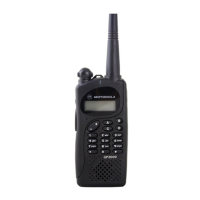7-8 Theory of Operation
C486, L404-L406, Q405 and R410. The output from the band-pass Þlter is directed to the mixerÕs
Q407/L407.
3.7.2 Local Oscillator (LO)
The Receive VCO (C344-C351, L302, L305, L306, L312-L314, Q311, and Q324) provides the LO
signal. The VCO is running at 45.1 MHz above the desired receive frequency and is applied to
output Buffer Q308/Q416. The output of the buffer is sent through the low-pass Þlter C430, C431,
L409, and to the mixer Q407/L408.
3.7.3 Mixer
The mixer is a DBM type (L407, Q407, L408). The mixer LO frequency is 45.1 MHz above the
desired receiver frequency. When the receiver frequency is present, the mixer output will be a
45.1MHz signal. The mixer output is peaked for 45.1MHz at L410, C432 and R413, and the signal is
Þltered by crystal Þlter F402 and ampliÞed by Q408 before being sent to IF IC Q506. The 45.1MHz
IF signal and LO frequency of 44.645 MHz (X501) are mixed in Q506. The 455kHz ceramic Þlter,
F501 or F502, Þlters the second mixerÕs output. The resulting signal is the second IF signal. The
mixerÕs output is then fed to the internal limiting ampliÞer, and consequently to the FM decoder.
3.7.4 FM Detector and Squelch
The FM detector output is used for squelch, decoding tones and audio output. The squelch ampliÞer
is inside of Q506, and its output is fed to an internal rectiÞer and squelch detector. The output on
Q506 Pin 14 signals the CPU Q101 with a low (~0V) to unmute the radio. The audio is unmuted by
the CPU Q101 Pin 41 switching to a high (5V), thus biasing on Q503. The audio is then routed to the
audio ampliÞer Q702 via the volume control SW201.
3.7.5 Receiver Audio Circuit
The detectorÕs audio output also is fed to the tone (CTCSS and DCS) low-pass Þlter Q505A. Then
the output of the low-pass Þlter is routed to the second stage Þlter Q505B. The output of Q505B is
passed to Q505C. The output of Q505C is directed to the squaring circuit Q505D, and Þnally to the
CPU Q101 Pin22 for decoding.
The detector output feeds the audio high-pass Þlter Q502. The output of the audio high-pass Þlter
feeds the Volume Control SW201 (VOL). From the wiper arm on the Volume Control, the audio is
routed to Pin 4, which is the input to the audio power ampliÞer Q702. The output of the audio power
ampliÞer is routed through the earphone jack J701 to the internal speaker SP701.
3.8 Battery Section
The battery connects to the contact (CN201). The positive terminal of the battery connects to the
ON/OFF Volume control switch (SW201), and the negative terminal connects to PWB ground. Low
battery is detected by R127/R128 and voltage regulator Q204.
Battery voltage status is monitored by Pin 19 of the CPU Q101 through R127/R128. When the
battery voltage goes below the threshold voltage, "LOW BATT" is displayed on LCD LC101. In the
BATTERY SAVER Mode, the CPU Q101 generates a square wave signal on Pin 37. The signal's
duty cycle varies according to what the BATTERY SAVE TIMER is set. When the signal goes high
(approximately 5 V), Q210 is biased off, and Q211 is cut off, thus turning the supply off to IF IC
Q506.

